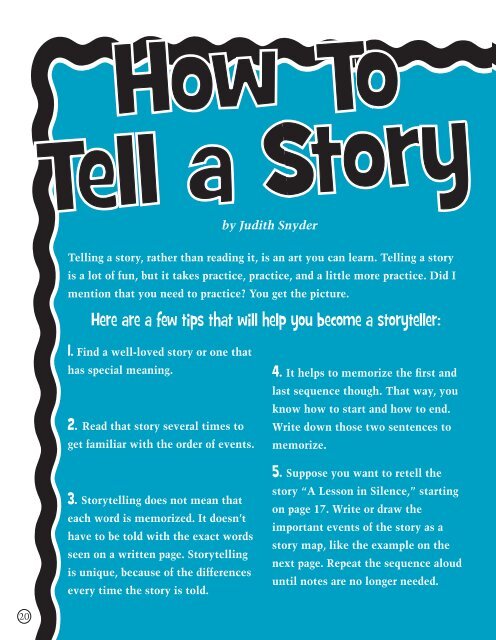HowToTell a Story. - Judith Snyder
HowToTell a Story. - Judith Snyder
HowToTell a Story. - Judith Snyder
You also want an ePaper? Increase the reach of your titles
YUMPU automatically turns print PDFs into web optimized ePapers that Google loves.
y <strong>Judith</strong> <strong>Snyder</strong><br />
Telling a story, rather than reading it, is an art you can learn. Telling a story<br />
is a lot of fun, but it takes practice, practice, and a little more practice. Did I<br />
mention that you need to practice? You get the picture.<br />
Here are a few tips that will help you become a storyteller:<br />
1. Find a well-loved story or one that<br />
has special meaning.<br />
2. Read that story several times to<br />
get familiar with the order of events.<br />
3. <strong>Story</strong>telling does not mean that<br />
each word is memorized. It doesn’t<br />
have to be told with the exact words<br />
seen on a written page. <strong>Story</strong>telling<br />
is unique, because of the differences<br />
every time the story is told.<br />
4. It helps to memorize the first and<br />
last sequence though. That way, you<br />
know how to start and how to end.<br />
Write down those two sentences to<br />
memorize.<br />
5. Suppose you want to retell the<br />
story “A Lesson in Silence,” starting<br />
on page 17. Write or draw the<br />
important events of the story as a<br />
story map, like the example on the<br />
next page. Repeat the sequence aloud<br />
until notes are no longer needed.<br />
20
Kima says he left his<br />
heart in the tree.<br />
Papo invites<br />
Kima for<br />
a ride.<br />
swim home<br />
Kima lives in a tree.<br />
Kima silent<br />
Kima says no.<br />
Papo offers bananas.<br />
Kima comes down.<br />
Papo leaves.<br />
chatters<br />
eats bananas<br />
swim away<br />
throws peel<br />
Papo says<br />
father needs a monkey<br />
heart.<br />
21
6. Now it’s time to make the<br />
story unique. Try giving the main<br />
character a different voice. There<br />
are many ways to do this, such as<br />
a lisp, a teenage way of talking,<br />
a deep and low voice, or a sweet<br />
high voice. Be inventive.<br />
7. Try the different types of<br />
voices aloud, until one fits the<br />
character. Hearing it and feeling<br />
it on the tongue is important.<br />
(Hint: When first learning, use<br />
only one different voice to avoid<br />
any mix-ups).<br />
8. Another way to add spice is to<br />
include a repeating phrase. Some<br />
stories already have them, like,<br />
“I’ll huff and I’ll puff… .” Other<br />
times, a phrase can be added. If the<br />
character does a lot of walking, the<br />
storyteller can repeat, “He walked<br />
up, up, up, down, down, down,<br />
over and around,” or “thump,<br />
thump, tippy toe, tippy toe.” Be<br />
creative.<br />
9. Now it is time to practice, and<br />
it must be done out loud. Use the<br />
story map or notes for a while, but<br />
gradually get rid of them. Tell the<br />
story to the mirror, pets, parents,<br />
brothers or sisters, friends, or<br />
anyone who will listen. Record<br />
yourself on a tape recorder. Then<br />
listen to the recording to identify<br />
areas that need work.<br />
10. When you are ready, find an<br />
audience. Perhaps there is an<br />
opportunity at school or at a club<br />
meeting. Invite grandparents over<br />
for a special evening. Position<br />
the audience in front of you, turn<br />
down the lights, get everyone<br />
quiet, and begin.<br />
Caution: The storytelling bug<br />
is very contagious, and if it<br />
gets a good hold of you, it<br />
may never go away.<br />
Good luck!<br />
22


